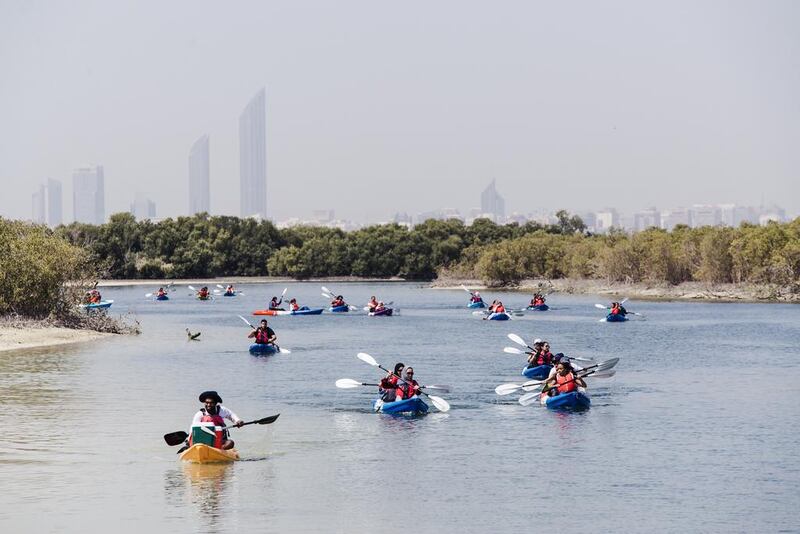ABU DHABI // Ever heard of jumping fish that skip across the water, or a forest where roots shoot straight up in the air to breathe?
This may sound like the stuff of fiction but both can be found at Eastern Mangrove Lagoon National Park.
Mohammed Al Otaiba, The National’s Editor-in-Chief, on Saturday hosted a small group of dignitaries, readers and experts on a tour of the mangroves as part of The National Excursions, a new series created to introduce the community to the hidden gems of the UAE.
“It’s a combination of discovery, adventure, learning and entertainment,” said Laura Koot, The National’s Managing Editor.
The original plan called for invited guests, including Arif Lalani, Canada’s ambassador to the UAE, reader Janice Liu and experts from the Environment Agency Abu Dhabi, or Ead, to paddle around the mangroves on Sea Hawk kayaks.
But the group boarded a small boat so that they could cover a larger area in a shorter time, and set off on their adventure.
As they glided slowly through the canal, Dr Himansu Sekha Das and Salim Javed, both from Ead, spoke about the mangrove’s place in the nation’s environment.
About 75 per cent of the UAE’s 450 species of birds can be found in Abu Dhabi, and about 40 or 50 of these can be seen in the mangroves.
Among the most frequently seen is the western reef heron, also known as the western reef egret – an elegant bird with tall legs, a long beak and feathers that are either a dark blue-grey or white.
Another resident species, the blackwing stilt, was also easy to spot among the marshes.
“Its legs are very slim, slender, like a stilt,” Mr Javed said.
The mangroves also attract migratory birds, he said, but at this time of year many of these have started to return home to breed.
“They start arriving from northern migration in late September and they stay here close to six months,” said Mr Javed. “Most of the birds are here until February.”
Ead tracks some of the birds to learn more about their migration patterns.
“We have got some fantastic results from where they go, where they end up and how they are using different areas,” said Dr Das.
Ead is working with agencies in other countries to develop more protected areas for the migratory birds.
“With protected species you just don’t need to protect one area, you need to have a network of sites in order for them to feed and rest,” Dr Das said.
As he was speaking, needlefish began to fly out of the canal and skip rapidly across the still water, almost as if they were putting on a show for the visitors.
“Oh, skipping fish,” one guest said in surprise. “Did you see them jump?”
The mangroves were teeming with wildlife. Small black crabs crawled over the rocks, schools of fish big and small raced just beneath the surface of the clear, algae-rich green water as majestic birds flew overheard. Foxes have made their home there.
“There are still new species being found,” said Mr Javed. “Within Abu Dhabi we found four species of invertebrate last year, which are new to science.”
In the mangroves, there are five types of plant roots. One of the more peculiar, found in Abu Dhabi’s Grey Mangrove on Eastern Mangroves National Park, is the aerial root.
It looks like a thick, pointed pencil sticking up from the soil to absorb oxygen.
“Mangroves, seagrasses and saltmarshes are responsible for absorbing more carbon than terrestrial plants,” said Dr Das. “These plants have unlimited ability to absorb carbon, but terrestrial plants have limited ability.”
As the tour neared its end, the visitors were rewarded with the sight of flamingos taking flight from a sandbar as more needlefish raced across the water.
“It was wonderful, it was so insightful,” Ms Liu said of the tour. “What I really found most enriching is to know the kind of efforts we’re doing in the UAE and how it has relevance throughout the world and region.”
Mr Al Otaiba said the group had learnt a lot. “We’ve seen a side of the UAE we haven’t seen before. I have to come back to kayak, definitely. There is just so much to take in.”
Mr Lalani asked that everyone visiting the boardwalk stop littering. “We should take care of that. I walk there every morning and it angers me to see people just leave their litter.”
rpennington@thenational.ae
____________________________________________________________
READ MORE ABOUT THE MANGROVES:
• The Lungs of Abu Dhabi: A billion-dollar ecosystem
• Environment Agency - Abu Dhabi implements mangrove protection legislation
• Eco-treasure hiding in Abu Dhabi mangroves
• Masdar student taps Abu Dhabi's mangroves for food and fuel
• Mangroves need more than guidelines for protection, planner says
• Thousands of mangroves planted in Abu Dhabi, and more to come






